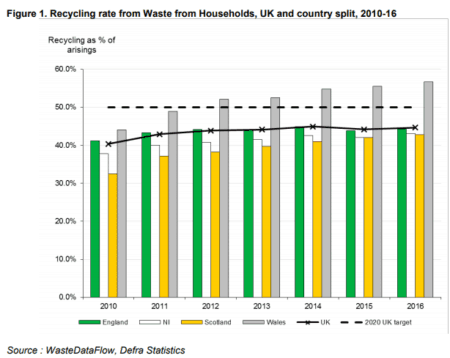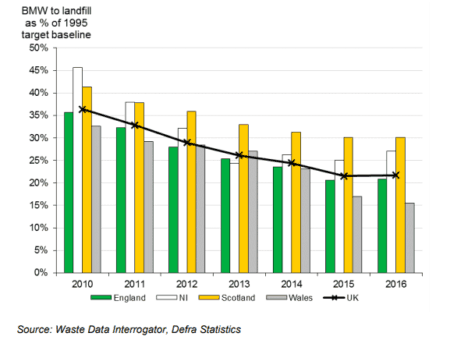The latest Defra statistics have revealed that the UK recycling rate for Waste from Households rose by 0.6% to 45.2% in 2016.
However, the increase has been credited partly due to the inclusion of incinerator bottom ash (IBA) metals in the figures, rather than advances in dry recycling from households. This has led to continued concerns that the UK may fail to meet an EU target of 50% by 2020.
The figures also include a revision of estimates over the amount of waste generated by businesses.
England and Scotland have both included incinerator bottom ash (IBA) metals for data from 2015 onwards. This material is metal contained in the ash that is left over after waste is burnt in an incinerator. Wales has included the material in its recycling rates from 2012.
In a statistical release on the figures, Defra noted: “The inclusion of IBA metal in the WfH [Waste from Households] recycling data causes a small increase in WfH recycling rates. For example, for 2016, the UK WfH recycling rate including IBA metals is 45.2%, a 0.6 percentage point increase from 44.6% if IBA metals are excluded.”
UK split
The statistics showed that Wales was again the best performer in the UK, with 57.3% of waste recycled or composted. Wales was followed by England, with 44.9%, 43.0% in Northern Ireland and 42.8% in Scotland.
Wales’ figures for 2012-2014 were revised in the release to remove IBA metals. These are included for 2015 and 2016 in line with the other UK countries. In Northern Ireland no local authority collected municipal waste went directly to incinerators.
Packaging
The figures also reveal that in 2016, 71.4% of UK packaging waste was either recycled or recovered. This was above the EU target of 60% and higher than the 64.7% achieved in 2015. Every packaging material surpassed EU recycling targets. Plastics reached 44.9% against an EU target of 22.5% for the year. Metal achieved a recycling rate of 68.7 % while the EU target was 50%.
Recycling accounted for 7.4 million tonnes of the 11.5 million tonnes of packaging waste arisings in 2016, with a further 0.8 million tonnes recovered by use in ‘energy from waste’ incineration. Paper and cardboard had the highest waste arisings, at 4.7 million tonnes. The highest recycling rate achieved in 2016 was 81.9% for paper and cardboard, followed by 68.7% for metal and 67.1% for glass.
For biodegradable municipal waste (BMW) sent to landfill, the UK sent 7.6 million tonnes to landfill in 2016, representing 22% of its overall waste. This comfortably met the EU target of no more than 35%.
Commercial and industrial
The report also revealed that previously published commercial and industrial waste generation estimates for 2010 and 2012-2014 for England have been substantially revised following “consultation with industry and a detailed review of the methodology”.
Revised figures estimate UK generation of commercial and industrial (C&I) waste at 41.9 million tonnes in 2014, of which 32.8 million tonnes was generated in England. Provisional estimates for England only indicate that waste generation has since fallen to around 32.2 million tonnes in 2016.
Reaction

ESA executive director Jacob Hayler welcomed the proposals but expressed his concerns over EU targets
Commenting on the data, Environmental Services Association (ESA) executive director, Jacob Hayler, said that while the increases are welcome, it shows further proof that more government policy action is needed through a waste and resources strategy, which is expected to be published later this year.
He said: “While the UK’s 2016 recycling rate for waste from households shows an improvement over 2015, partly due to the inclusion of IBA metals, it provides further proof that on current policies, the UK will not reach 50% recycling by 2020, let alone the higher rates provisionally agreed at EU level. As ESA has already pointed out, Defra’s impending resources and waste strategy will need to address the issue of sustainable markets for recyclable materials, as well as the UK’s residual waste capacity gap.”
Mr Hayler added that he is glad to see the commercial and industrial statistics updated. “The new approach tallies better with industry’s own analysis and other data sets, which gives more confidence and clarity around the reported figure,” he said.
The post Defra reports 45.2% recycling rate for 2016 appeared first on letsrecycle.com.
Source: letsrecycle.com Packaging




